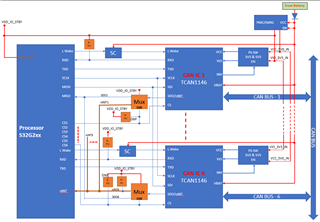Other Parts Discussed in Thread: SN74LVC1G3157-Q1,
Hi TI Team,
We are using TCAN11446, we want to use RXD pin as wake up source for processor to be woken up.
In sleep mode of TCAN1146 VCC & VIO are not available, we are turning ON VCC & VIO supplies of TACN1146 based on INH pin state.
Please confirm for the above our configuration whether RXD pin ca be used as wake up source for processor to be woken up.


